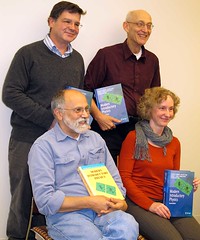Physics department faculty members Charlie Holbrow, Jim Lloyd ’54, Joe Amato,
Kiko Galvez, and Beth Parks have spent the last four years working together on a
revision of the Colgate-inspired Modern Introductory Physics.
The second edition of the textbook was released this semester after they passed a final summer poring over printer’s proofs.
Last Wednesday, the faculty members shared some laughs, signed copies of the
book, and celebrated its completion with colleagues and friends in the Robert
H.N. Ho Science Center’s faculty lounge.
At the authors’ request, royalties support a special fund to underwrite departmental initiatives and guest speakers. The volume will continue to be used as the central text for Physics 120, a calculus-level survey class that has set Colgate apart for decades.
Back in the early 1980s, physics enrollment was down; Holbrow, Lloyd, and Amato set out to determine why and fix the problem. One of their solutions was to redesign the introductory course.
 They found that they needed to bring incoming first-years back up to speed gradually on algebra and trigonometry. They also wanted to “reduce the sensation of drinking from a fire hose,” remembered Holbrow. So they detoured, where possible, around the mass of standard fare from Newton or Galileo, focusing instead on current concepts that answer the question, “why do we believe in atoms?”
They found that they needed to bring incoming first-years back up to speed gradually on algebra and trigonometry. They also wanted to “reduce the sensation of drinking from a fire hose,” remembered Holbrow. So they detoured, where possible, around the mass of standard fare from Newton or Galileo, focusing instead on current concepts that answer the question, “why do we believe in atoms?”
The result was less overwhelming and more engaging. “Most universities start with mechanics,” said Galvez. “But ask physicists what’s exciting, and they’ll say something like ‘photons’.”
A new approach to modern physics required a different textbook. So Lloyd, Holbrow, and Amato wrote one to support their syllabus. Quoting Winston Churchill’s exhortation to “be strong, be brave, be persistent,” it thoughtfully presents the topic to students who are re-introducing themselves to physics after a hiatus from the high school lab.
The pedagogy has returned Colgate’s physics department to its historic popularity and has been adopted by universities like Western Kentucky and Bryn Mawr. It has been successful enough to warrant the re-issuing of the book, updated with the help of faculty members who have arrived since that original brainstorming session decades ago.
In its latest incarnation, Modern Introductory Physics — and its complementary lab material — further distances itself from pulleys and planes to present fundamental principles of quantum mechanics. “We end the new edition touching on the new physics of the 21st century,” said Galvez.
“If there’s to be a third edition,” Holbrow added, “it will be Beth and Kiko who produce it. They are the future.”